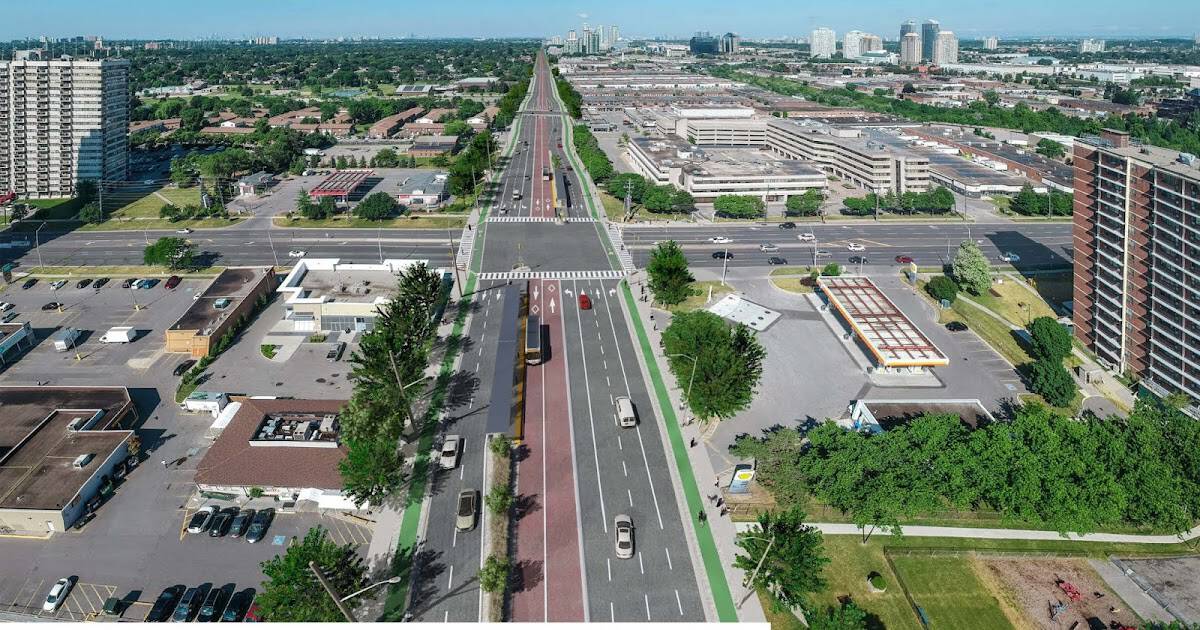Design work ready for public review on $1 billion Oshawa to Scarborough rapid bus line
Published October 17, 2024 at 2:52 pm

Planning and design work for the Durham-Scarborough Bus Rapid Transit (BRT) project has been completed, with design options and business cases available for public review.
The BRT will connect Scarborough and Durham Region with a 36-kilometre dedicated rapid bus line that will travel from Scarborough Town Centre through Pickering, Ajax and Whitby and into Oshawa on the Highway 2 corridor.
The price tag for the project is likely to exceed $1 billion, with the current end point in downtown Oshawa, with connections to the new Central Oshawa GO station planned at the old Knob Hill Farms site.
Spur lines to Durham College/Ontario Tech University are also in the works.
The planning and design work also included environmental studies and the completion of two business cases which evaluated the preferred design and project benefits.
Preliminary work is already underway, with the $115 million first phase funded through the federal government ($45.8 million), Queen’s Park ($38.1 million) and Durham Region ($30.5 million), completed in 2021.
The purpose of the Durham-Scarborough BRT project is to create seamless connections with local transit networks along the high-demand Highway 2-Ellesmere corridor, providing residents of Durham and Toronto more flexibility and choice to get where they need to go faster.
The need for such a transit service is even more acute with “significant” population and employment growth, with 43,000 new residents and 26,000 new jobs expected within a ten-minute walk of the corridor over the next couple of decades.
“The Highway 2-Ellesmere corridor is a crucial transportation corridor connecting people through Durham and Scarborough,” Metrolinx declared in the report.
Transit ridership along much of the corridor is currently served by DRT’s PULSE 900, which has 8,400 boardings on a typical weekday.
The report (which is available to view at BRT Planning & Design study) provides three options:
Option 1 represents the delivery of the entire BRT corridor and assumes that all preliminary design elements will be delivered and operating by 2033. This option involves the construction of 36 kilometres of BRT between Scarborough Centre and downtown Oshawa, with 49 stops in each direction
Option 2 calls for certain high-cost segments to be deferred and prioritizes the delivery of BRT infrastructure by minimizing the initial capital investment, putting off areas that require above average capital costs such as major utilities relocation, retaining walls, higher property impacts, and bridges or culverts.
With this option, three segments would be built after 2033, including Kingston Road, between Notion Road and Rotherglen Road (one km) in Ajax and Dundas Street, between McQuay Boulevard/Jeffrey Street and Anderson Street/Hopkins Street (3.7 km) in Whitby.
Option 3 prioritizes high-traffic segments and the delivery of infrastructure, land use development and transit passenger demand while minimizing the initial capital investment by deferring areas that have lower traffic volumes. This option has 56 stops in each direction, seven more than Option 1, and would defer three segments, including two in Oshawa: King Street, between Gibbons Street and Simcoe Street (1.3 km) and Bond Street, between Stevenson Road and Simcoe Street (1.8 km).
Net new daily riders are estimated at between 5,300 and 6,000, depending on the option chosen.

Capital costs for the project are pegged at $1.17 billion (Option 1), $859 million (Option 2) and $1.02 billion (Option 3). Operating costs for the three options range from $211 million to $240 million.
Metrolinx now moves on to look at a dozen or so next steps (while the public gets a chance to look at the options(, including:
Service Integration: Metrolinx and MTO are actively collaborating with the TTC, MiWay, Brampton Transit, YRT, and DRT to explore options that would support cross-boundary pilots that would allow these operators to serve TTC customers within Toronto.
Examine Connectivity to Bowmanville GO Rail Extension: Look at opportunities to connect the transit line to the future rail extension, including bus bay/layover requirements at the Central Oshawa GO station and the need to protect for potential eastward expansion of the BRT.
Identify Order of Magnitude of Cost Impacts of Deferring Segments Beyond 2033: If Option 2 or 3 are selected, considering aspects such as duplication of effort in procurement, construction phasing and/or loss of economy of scale during construction of the initial infrastructure.
A rapid transit corridor connecting Durham and Scarborough was first proposed in 2007 in response to federal and provincial funding programs to improve mobility in the GTHA. The project was given the preliminary green light in 2010.
Some of the work on the transit line is expected to be completed by next year with the second phase to be delivered by the end of 2027. Stages three and four in the project would be done by 2030 while the final phase – barring any possible deferments – should be operational by 2033.

INdurham's Editorial Standards and Policies





